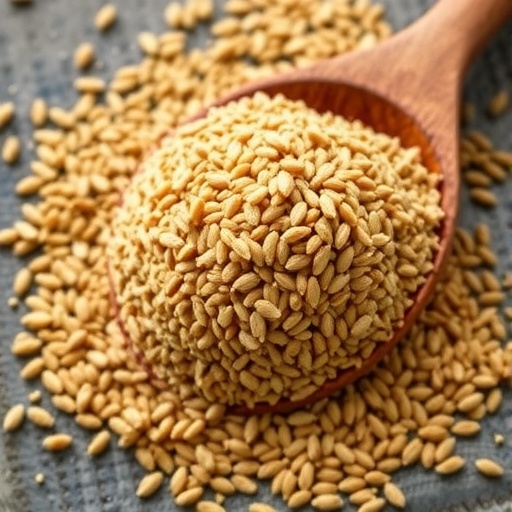In a groundbreaking study, researchers have turned their attention to millet lees, a byproduct of fermented beverages that has long been overlooked in the realms of nutritional science and food technology. Conducted by a team led by experts in the field, including R. Selvaraj, A. Annamalai, and S. Kalakandan, this research offers novel insights into the nutritional, functional, and structural properties of millet lees, providing a comprehensive analysis that could pave the way for more sustainable and health-conscious food products.
Millet, a small-seeded grass traditionally cultivated in various parts of the world, is known for its resilience and adaptability to harsh climate conditions. However, the fermentation processes associated with beverages derived from millet have historically led to significant amounts of waste. The new study reveals that what has been discarded as waste may actually hold critical nutritional benefits and functional properties that are worthy of exploration.
The researchers employed a series of analytical techniques to delve into the composition of millet lees, aiming to uncover its nutritional profile. Their findings suggest that millet lees are rich in essential nutrients such as proteins, fibers, vitamins, and minerals. This discovery opens the door to reconsidering millet lees not merely as waste but as a valuable resource that can enhance the nutritional value of various food products.
Moreover, the study highlights the functional properties of millet lees. Beyond basic nutrition, the lees exhibit significant antioxidant, antibacterial, and anti-inflammatory properties, suggesting potential health benefits. These functional properties can play a vital role in promoting overall well-being and reducing the risk of chronic diseases. By incorporating millet lees into dietary practices, individuals may find a new ally in the pursuit of health.
From a structural standpoint, the research employs state-of-the-art technologies to elucidate the physical characteristics of millet lees. Understanding the macro and microstructure of this byproduct is crucial for food technologists and product developers looking to innovate with natural ingredients. The study sheds light on the texture and composition of millet lees, providing insights that can be leveraged to optimize their functionality in food applications.
The implications of this research extend beyond individual health benefits. By recognizing millet lees as a valuable ingredient, the food industry can take strides toward reducing waste and promoting sustainability. As environmental concerns continue to grow, innovations in using byproducts like millet lees can support sustainable practices by minimizing food waste and creating new value-added products.
Millet plants are often cultivated in arid regions where other crops may struggle to thrive. This adaptation makes millet an excellent candidate for sustainable agriculture in the face of climate change. Given the nutritional and functional benefits of millet lees, promoting its use could encourage farmers to cultivate millet, further bolstering food security.
Additionally, this research contributes to the global conversation around food waste. In many societies, food byproducts are often discarded without giving a second thought to their potential uses. The findings of Selvaraj and colleagues challenge this mindset and advocate for a more resourceful approach to food production, where every part of the plant is utilized to its fullest extent.
The study’s focus on millet lees could also inspire further research into other food byproducts. As scientists and food technologists seek to maximize resource efficiency, understanding the properties of lesser-known byproducts holds immense potential. By expanding the scope of research to include various food waste materials, the industry can discover innovative solutions for tackling food insecurity and environmental challenges.
Furthermore, the findings could play a pivotal role in addressing nutrient deficiencies prevalent in many populations. Incorporating millet lees as a functional ingredient in mainstream diets may offer a cost-effective way to enhance nutritional profiles in various food products, especially in developing regions where access to diverse food options is limited.
As the world shifts toward more sustainable and health-focused diets, the revelation of millet lees as a nutritional powerhouse could not be timelier. This research exemplifies the potential of scientific inquiry to transform our understanding of food waste and drive a cultural shift toward responsible consumption.
Ultimately, the analytical characterization of millet lees presents a compelling case for redefining waste in the food industry. It encourages stakeholders—from farmers and manufacturers to consumers—to view byproducts not with disregard, but with a sense of opportunity. This research is a clarion call for innovation, urging us to rethink our food systems in light of sustainability and health.
In conclusion, the groundbreaking work led by Selvaraj, Annamalai, and Kalakandan serves as a blueprint for future research on food byproducts. By deepening our understanding of millet lees, this study not only elevates the status of an underappreciated byproduct but also opens up new avenues for sustainable practices in the food industry. Armed with these insights, the potential for millet lees to enrich our diets and contribute to a more sustainable future is brighter than ever.
Subject of Research: Analytical characterization of millet lees from fermented beverages
Article Title: Analytical Characterisation of Millet Lees from Fermented Beverages: Nutritional, Functional, and Structural Insights
Article References: Selvaraj, R., Annamalai, A., Kalakandan, S. et al. Analytical Characterisation of Millet Lees from Fermented Beverages: Nutritional, Functional, and Structural Insights. Waste Biomass Valor (2025). https://doi.org/10.1007/s12649-025-03223-1
Image Credits: AI Generated
DOI: 10.1007/s12649-025-03223-1
Keywords: Millet, Lees, Fermented Beverages, Nutritional Insights, Functional Properties, Food Waste, Sustainability, Health.




